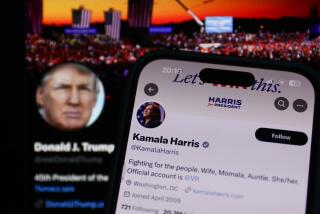Not many months from now, people across...
- Share via
Not many months from now, people across the country will experience one of the great recurring features of American democracy. At shopping malls, on factory floors, at church socials and even on our front stoops, we will be approached by individuals who want to represent us in public office. While chances are high that we won’t know them personally, they will walk up to us, offer a handshake and a flier and ask for our votes.
Just as technology is affecting every other area of communication, it has begun to affect the way political candidates communicate with voters.
In this year’s GOP gubernatorial primary, California Secretary of State Bill Jones, who faced better-funded candidates, acquired the e-mail addresses of more than a million potential California voters and sent each an unsolicited e-mail asking for support.
That day, he might have chosen any of the more traditional--and more expensive--methods of contacting voters, such as direct mail, radio spots or TV ads. But he spent only about 2 cents per message, instead of 35 cents or more per message for direct mail or in another medium.
Had Jones chosen direct mail, radio or TV, that communication would have been equally “unsolicited,” as defined in the e-mail world. Few voters would have “opted in” to receive campaign information from Jones through any of those channels.
The response to Jones’ e-mail effort, however, was swift and intense. He was lambasted by anti-spam advocates, and media coverage was almost entirely negative. To be fair, some of Jones’ tactics could have been refined. He used a less-than-perfect list and no standard-practice “paid for” disclaimer in the message.
His detractors, however, attacked him not for his tactical miscues but because the e-mail was sent unsolicited. In fact, Jones’ online campaign may have been his most visible asset. In an era of cynicism toward money in politics--money typically spent on other unsolicited communication mediums--Jones tried to level the playing field.
No one likes commercial spam. It is irrelevant and untargeted and can be highly intrusive and even offensive. But as a sophisticated society, it’s time to differentiate commercial spam from very different unsolicited e-mail sent by political candidates to voters.
The debate is particularly relevant in light of legislation in Congress that would constitute the first federal law to directly address spam. We believe e-mail is no more intrusive than direct mail, telemarketing or TV advertising when it comes to politicians seeking to reach voters. A simple link in good e-mail campaigns allows recipients to opt out of future mailings. Direct mail takes at least a phone call or stamp to be taken off a list, and viewers must repeatedly endure TV ads.
When a candidate lacks a large campaign war chest, he or she can use the Internet to provide constituents with information to better prepare them to perform their civic duty of casting educated votes. With more than 60% of all potential voters in this country possessing e-mail accounts, it makes sense that political candidates use this medium.
Candidates might avoid some of the tactical problems encountered by the Jones campaign if they use the technologies available today that better ensure quality of e-mail lists and target content to specific recipient groups.
But the broader point remains. When a political candidate sends a voter an e-mail, that recipient can choose to delete the message without opening it, unsubscribe from the list, read it or even reply and engage the sender. That choice should belong to the voter--not to anti-spam advocates whose efforts are better focused on commercial e-mail. Political candidates should be free to communicate with voters as best they can, and let voters decide what to do with that information.
More to Read
Get the L.A. Times Politics newsletter
Deeply reported insights into legislation, politics and policy from Sacramento, Washington and beyond. In your inbox twice per week.
You may occasionally receive promotional content from the Los Angeles Times.







